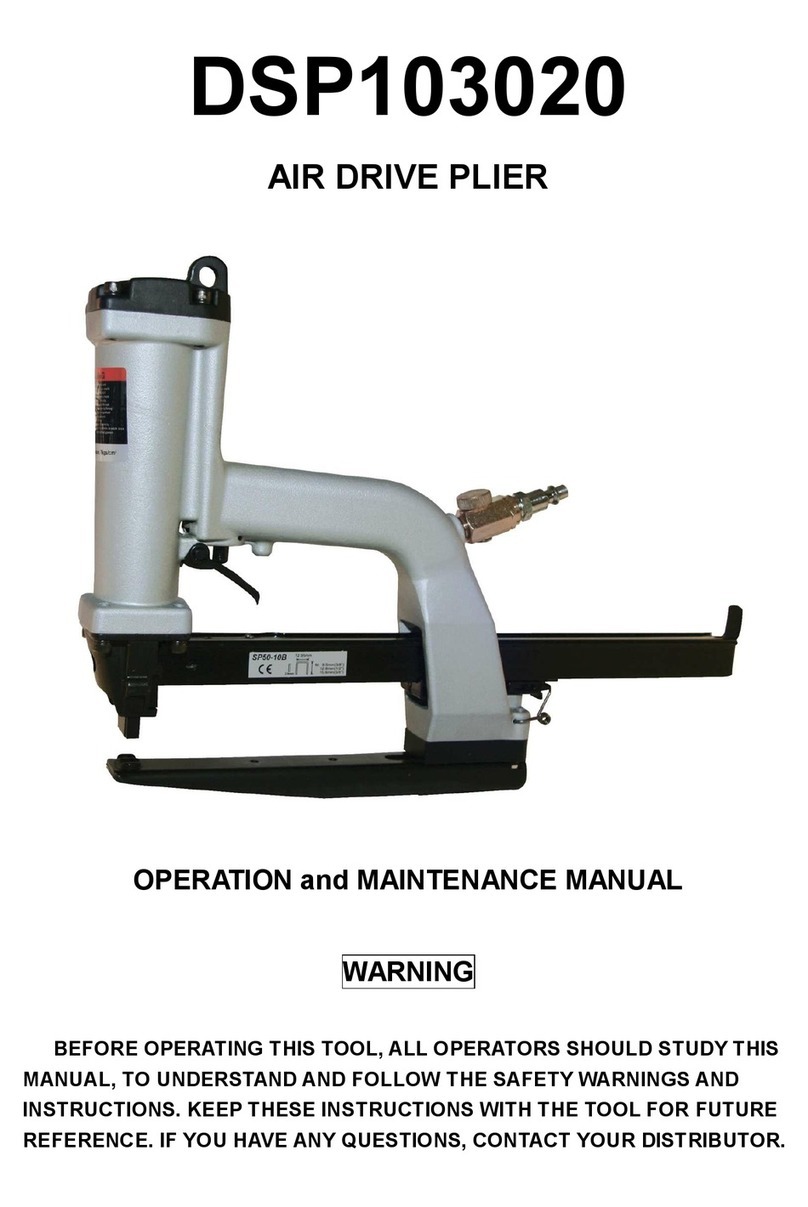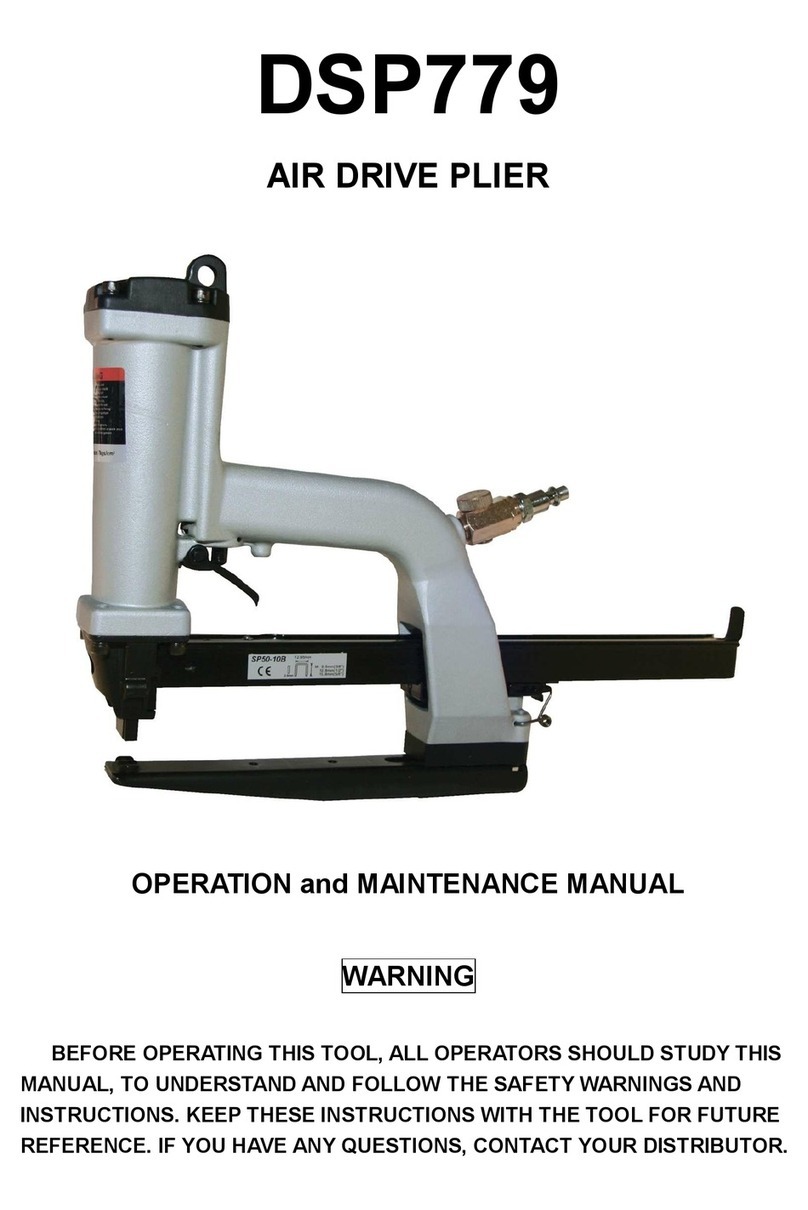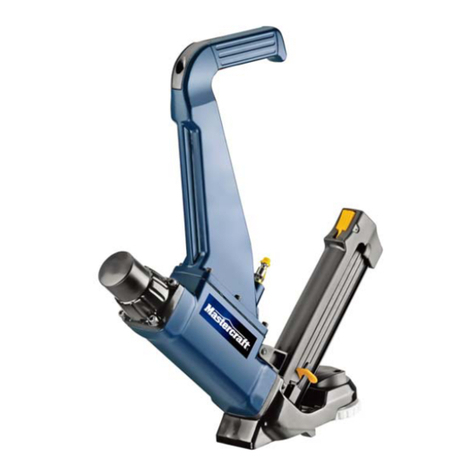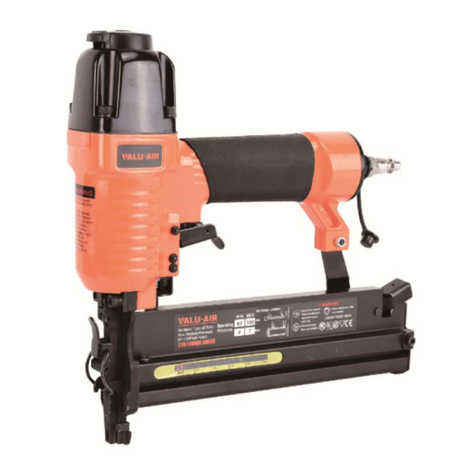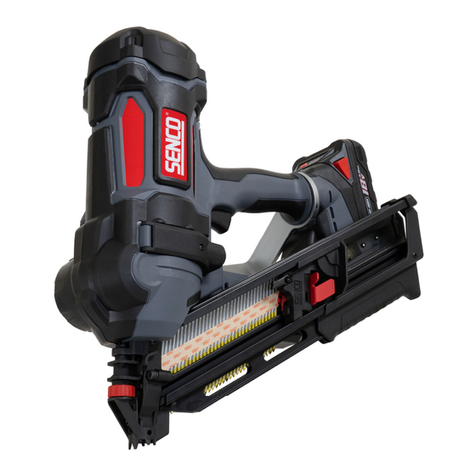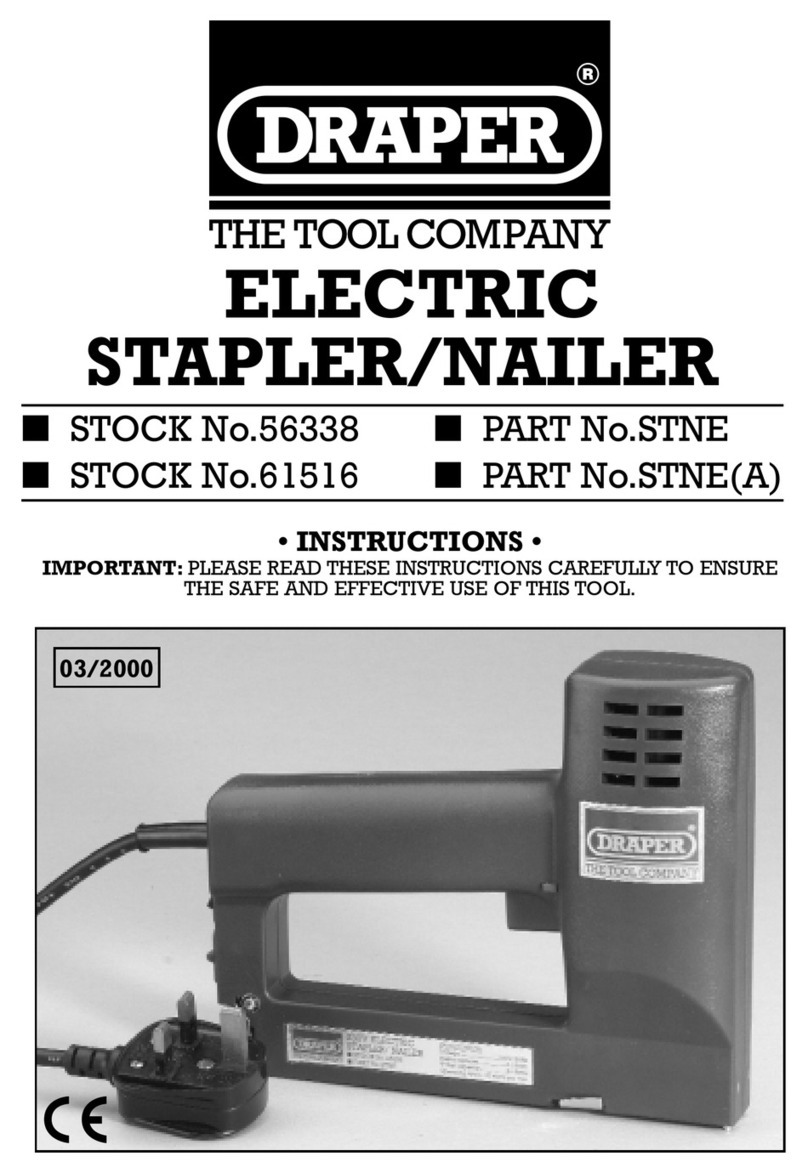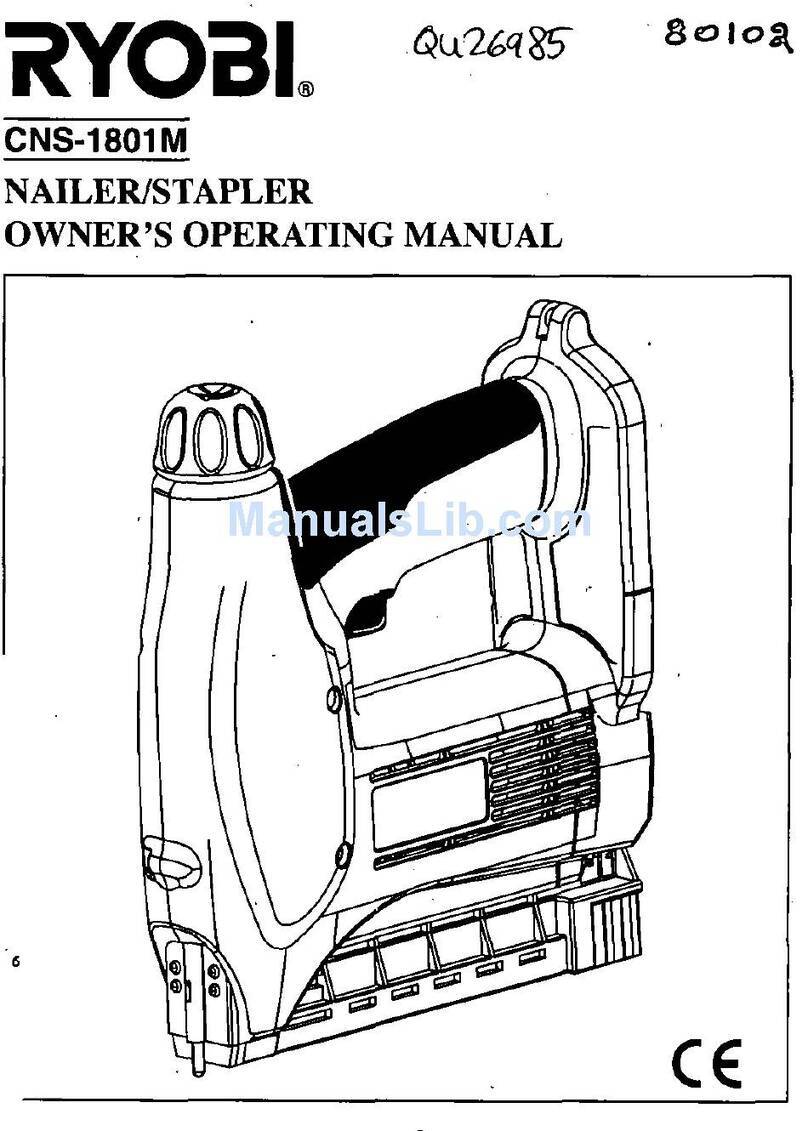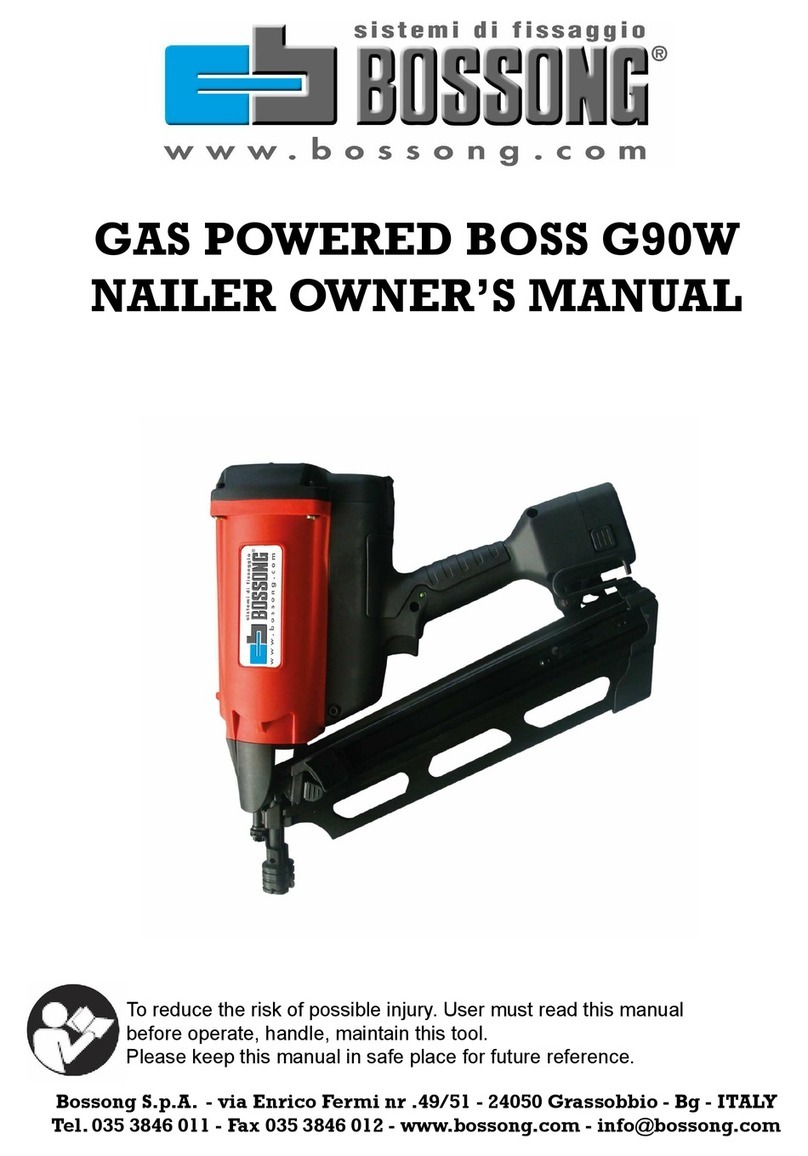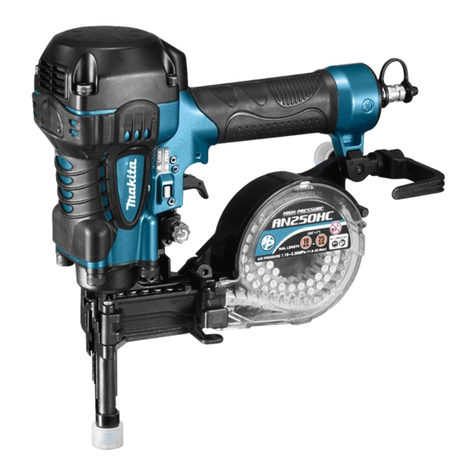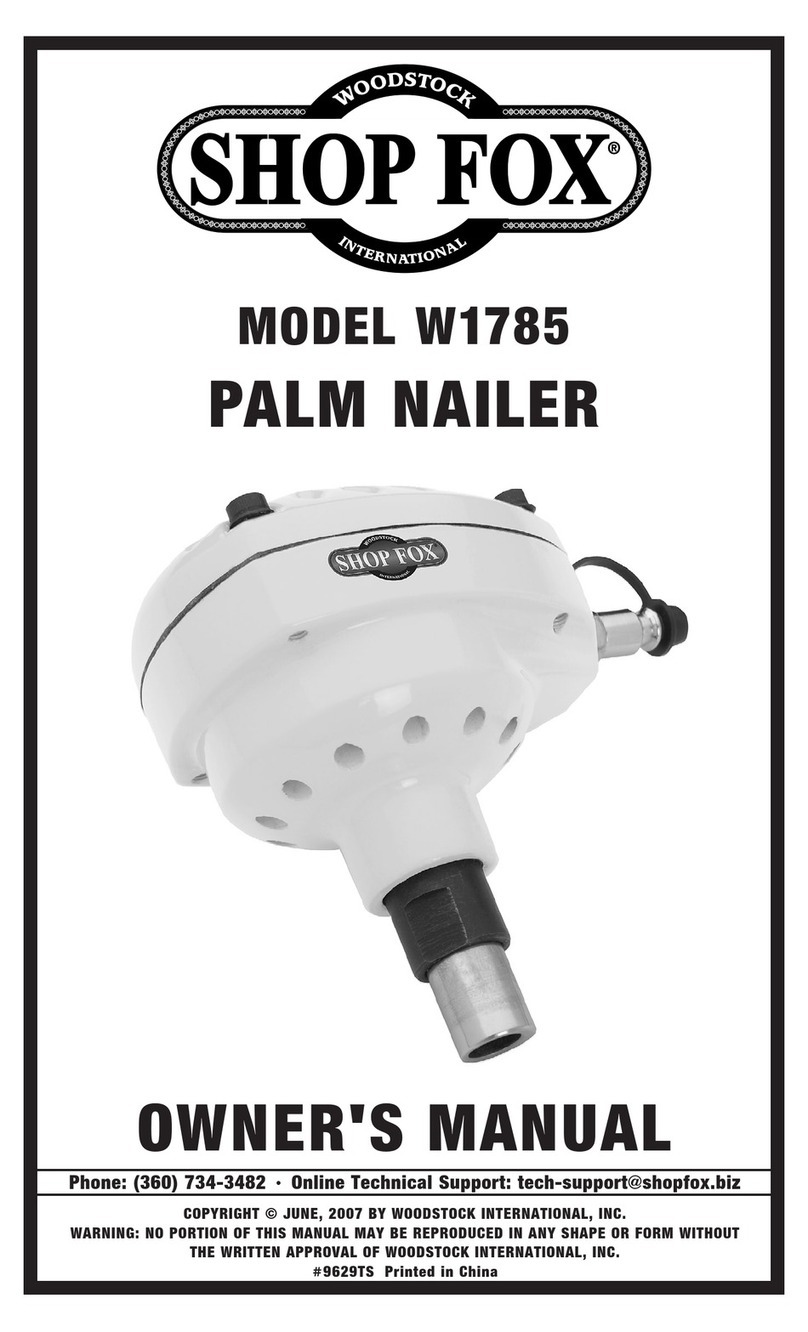Spotnails SFN19 User manual

Operating Manual
--SFN19 Flooring Coil Nailer--
NOTE: Please read and fully understand the instructions in this
manual before operating the pneumatic power tool. Carefully read
through this OPERATOR'S MANUAL to ensure efficient, safe
operation. It is recommended that the Manual be kept readily
available as an important reference when using this tool.
IMPORTANT INFORMATION

WARNING: The warnings, cautions and instructions discussed in this
instruction manual cannot cover all possible conditions and situations that
may occur. It must be understood by the operator that common sense and
caution are factors which cannot be built into this product but must be
supplied by the operator.
When using the tool, basic safety precautions should always be followed to reduce the risk
of personal injury and damage to equipment.
Read and understand tool labels and operating instructions, safety precautions and
warnings in this manual before operating or maintaining this nailer.
Failure to follow warnings could result in DEATH or SERIOUS INJURY.
Most accidents that result from the operation and maintenance of nailers are caused by the
failure to observe basic safety rules or precautions. An accident can often be avoided by
recognizing a potentially hazardous situation before it occurs and by observing appropriate
safety procedures.
Basic safety precautions are outlined in the "SAFETY" section of this manual and in the
sections, which contain the operation and maintenance instructions. Hazards that must be
avoided to prevent bodily injury or tool damage are identified as DANGERS or WARNINGS
on the nailer and in this manual.
Never allow the nailer to be operated by children or individuals who have not reviewed this
manual.
OPERATE THE NAILER ACCORDING TO THIS MANUAL.
WARNING!
Always follow the tool manufacturer's safety and
maintenance instructions.
Always wear appropriate safety glasses & ear protection
when operating or servicing tools.
Always disconnect the air supply from the tool and empty
the magazine when servicing tools.
SAVE THIS MANUAL
FOR FUTURE REFERENCE!

WARNING:
The operating instructions shall draw attention to the following
a) Only those fasteners listed in the operating instructions may be used in the fastener
driving tools;
NOTE: The fastener driving tool and the fasteners listed in the operating instructions must
be seen as one unit system in terms of technical safety.
b) Only the main energy and the lubricants listed in the operating instructions may be used;
c) Fastener driving tools marked with an inverted equilateral triangle standing on one point
may only be used with an effective safety yoke;
d) Fastener driving tools equipped with contact actuation or continuous contact actuation,
marked with the symbol “Do not use on scaffoldings, ladders”, shall not be used for specific
application for example:
when changing one driving location to another involves the use of scaffoldings, stairs,
ladders, or ladder alike constructions, e.g. roof laths, closing boxes or crates, fitting
transportation safety systems e.g. on vehicles and wagons;
e) For the maintenance of fastener driving tools, only spare parts specified by the
manufacturer or his authorized representative shall be used;
f) Repairs shall be carried out only by agents authorized by the manufacturer or by other
specialists, having due regard to the information given in the operating instructions;
NOTE: Specialists are those who, as a result of professional training or experience, have
sufficient expertise in the field of fastener driving tools and sufficient familiarity with relevant
governmental industrial protection provisions, accident prevention regulations, directives
and generally recognized technical regulations (e.g. CEN- and CENELEC-standards), to be
able to assess the safe working condition of fastener driving tools.
g) Stands for mounting the fastener driving tools to a support for example a work table,
shall be designed and constructed by the stand manufacturer, in such a way that the
fastener driving tool can be safely fixed for the intended use, thus for example avoiding
damage, distortion or displacement.
Additional instructions for fastener driving tools operated by compressed air
a) Fastener driving tools operated by compressed air shall only be connected to
compressed air lines where the maximum allowable pressure cannot be exceeded by a
factor of more than 10%, which can for example be achieved by a pressure reduction valve
which includes a downstream safety valve;
b) When using fastener driving tools operated by compressed air, particular attention must
be paid to avoid exceeding the maximum allowable pressure;
c) Fastener driving tools operated by compressed air should only be operated at the lowest
pressure required for the work process at hand, in order to prevent unnecessarily high
noise levels, increased wear and resulting failures;
d) Hazards caused by fire and explosion when using oxygen or combustible gases for
operating compressed air operated fastener driving tools.

SAFETY INFORMATION
WARNING:
BEFORE USING THE TOOL, READ CAREFULLY AND UNDERSTAND THE
FOLLOWING SAFETY INSTRUCTIONS.FAILURE TO FOLLOW WARNING
COULD RESULT IN DEATH OR SERIOUS INJURY.
1. WEAR SAFETY GLASSES OR GOGGLES.
Danger to the eyes always exists due to the possibility of dust being blown up by
the exhausted air or of a fastener flying up due to the improper handling of the
tool. For these reasons, safety glasses or goggles shall always be worn when
operating the tool. The employer and/or user must ensure that proper eye protection is
worn. The employer is responsible to enforce the use of eye protection equipment by the
tool operator and all other personnel in the work area. NOTE: Non-side shielded spectacles
and face shields alone do not provide adequate protection.
2. EAR PROTECTION MAY BE REQUIRED IN SOME ENVIRONMENTS.
As the working condition may include exposure to high noise levels which can
lead to hearing damage, the employer and user should ensure that any
necessary hearing protection is provided and used by the operator and others in
the work area.
3. DO NOT USE ANY POWER SOURCE EXCEPT AN AIR COMPRESSOR.
The tool is designed to operate on compressed air. Do not operate the tool on
any other high pressure gas, combustible gases (e.g. Oxygen, acetylene, etc.)
since there is the danger of an explosion. For this reason, do notuse anything
other than compressed air.
4. OPERATE WITHIN THE PROPER AIR PRESSURE RANGE.
The tool is designed to operate within an air pressure range of 70 psi
to100 psi (5 to 7 bar). The pressure should be adjusted to the type of
the work being fastened. The tool shall never be operated when the
operating pressure exceeds 120 psi. (8.3 bar).
5. DO NOT OPERATE THE TOOL NEAR A FLAMMABLE SUBSTANCE.
Never operate the tool near a flammable substance (e.g., thinner, gasoline,
etc.). Volatile fumes from these substances could be drawn into the
compressor and compressed together with the air and this could result in an
explosion.

6. DO NOT USE THE WRONG FITTINGS.
The connector on the tool must not hold pressure when air supply is disconnected. If a
wrong fitting is used, the tool can remain charged with air after disconnecting and thus will
be able to drive a fastener even after the line of air is disconnected, possibly causing injury.
7. DISCONNECT THE AIR SUPPLY AND EMPTY THE MAGAZINE WHEN THE TOOL IS
NOT IN USE.
Always disconnect the air supply from the tool and empty the magazine when operation has
been completed or suspended, when unattended, moving to a different work area,
adjusting, disassembling, or repairing the tool, and when clearing a jammed fastener.
8. INSPECT SCREW TIGHTNESS.
Loose or improperly installed screws or bolts cause accidents and tool damage when the
tool is put into operation. Inspect to confirm that all screws and bolts are tight and properly
installed prior to operating the tool.
9. DO NOT TOUCH THE TRIGGER UNLESS YOUR INTEND TO DRIVER A FASTENER.
Whenever the air supply is connected to the tool, never touch the trigger unless you intend
to drive a fastener into the work. It is dangerous to walk around carrying the tool with the
trigger pulled, and this and similar actions should be avoided.
10. NEVER POINT THE DISCHARGE OUTLET TOWARD YOURSELF AND
PERSONNEL.
If the discharge outlet is pointed toward people, serious accidents may be caused when
misfiring. Be sure the discharge outlet is not pointed toward people when connecting and
disconnecting the hose. Loading and not loading the fasteners or similar operations.
11. USE SPECIFIED FASTENERS.
The use of fasteners other than specified fasteners will cause the tool malfunction. Be sure
to use only specified fasteners when operating the tool.
12. PLACE THE DISCHARGE OUTLET TO THE WORK PROPERLY.
Failure to place the discharge outlet of the nose in a proper manner can result in a fastener
flying up and is extremely dangerous.
13. KEEP HANDS AND BODY AWAY FROM THE DISCHARGE OUTLET
When loading and using the tool, never place a hand or any part of body in fastener
discharge area of the tool. It is very dangerous to hit the hands or body by mistake.
14. DO NOT DRIVE FASTENERS CLOSE TO THE EDGE AND CORNER OF THE WORK
AND THIN MATERIAL
The work piece is likely to split and the fastener could fly and hit someone.

15. DO NOT DRIVE FASTENERS ON THE TOP OF OTHER FASTENERS.
Driving fasteners of the top of other fasteners may cause deflection fasteners which could
cause injury.
16. REMOVING THE FASTENERS AFTER COMPLETING OPERATION
If fasteners are left in the magazine after the completion of operation, there is the danger of
a serious accident occurring prior to the resumption of operation, should the tool be handled
carelessly, or when connecting the air removes all fitting. For this reason, always move the
fasteners away which remaining in the magazine after completion of the operation.
17. CHECK OPERATION OF THE CONTACT TRIP MECHANISM FREQUENTLY IN
CASE OF USING A CONTACT TRIP TYPE TOOL
Do not use the tool if the trip is not working correctly as accidental driving of a fastener may
result. Do not interfere with the proper operation of the contact trip mechanism.
18. WHEN USING THE TOOL OUTSIDE OR ELEVATED PLACE.
When fastening roofs or similar slanted surface, start fastening at the lower part and
gradually work your way up. Fastening backward is dangerous as you may lose your foot
place. Secure the hose at a point close to the area you are going to driver fasteners.
Accidents may be caused due to the hose being pulled inadvertently or getting caught.
19. NEVER USE THE TOOL IF ANY PORTION OF THE TOOL CONTROLS (e.g.,
TRIGGER, CONTACT ARM) IS INOPERABLE DISCONNECTED, ALTERED OR NOT
WORKING PROPERLY.
20. NEVER ACTUATE THE TOOL INTO FREE SPACE.
This will avoid any hazard caused by free flying fasteners and excessive strain on the tool.
21. ALWAYS ASSUME THAT THE TOOL CONTAINS FASTENERS.
22. DO NOT USE ON SCAFFOLDING LADDERS.
The tool shall not be used for specific application for example:
•When changing one driving location to another involves the use of
scaffoldings, stairs, ladders, or
•Ladder alike constructions, e.g. roof laths,
•Closing boxes or crates,
•Fitting transportation safety systems e.g. on vehicles and wagons.

TECHNICAL DATA
Type of tool
SFN19 Construction Coil Nailer
Dimensions
11-1/8”X4-1/4”X10-1/8”
248mmX108mmX260mm
Weight (without fasteners)
1.60kgs (3.50lbs.)
Actuation mode
Contact/Single-sequential actuation
Magazine capacity
200 nails (plastic sheet collated nails)
Maximum allowable pressure
120psi (8.3bar)
Recommended pressure range
70psi to 100psi (5bar to 7bar)
Fasteners
Only the nail sizes shown in the table below can be driven with this nailer.
15°Flat plastic sheet collated nails

NAILER CONNECTION AND OPERATION
NOTE: The information contained in this manual is designed to assist you in the safe
operation of the nailer. Some illustrations in this Manual may show details or attachments
that are different from those on your nailer.
Air Supply, Connections and Operating Pressure
Read section titled SAFETY. Make sure of the following before operation: Air Supply
Power Source (Compressor)
•Use only clean, dry, regulated compressed air as a power source.
•NEVER use oxygen or other bottled gases, as an explosion may occur.
•Use suitable air compressors used to supply compressed air to this tool.
•Moisture or oil in the air compressor may accelerate wear and corrosion in the
tools.
•Drain daily.
Connections
1. Fittings
Install a female coupling to the hose. The female coupling will connect to the quick release
that fits the tool.
2. Filter-Regulator-Lubricator
•NEVER connect the tool to pressure which potentially exceeds 120psi.
•Filter-regulator-lubricator units supply an optimum condition for the tool and extend
the tool life. These units should always be used.
Filter
•The filter removes moisture and dirt from compressed air.
•Keep the filter clean by maintaining regularly.
•Drain daily.
Regulator
•The regulator controls the operating pressure for safe operation of the tool.
•Inspect the regulator before operation to be sure it operates properly.

Tool Connection and Operation
Lubricator
•The lubricator supplies an oil mist to the tool.
•Inspect the lubricator before operation to be sure the supply of lubricant is adequate.
•If an inline lubricator is not used, a few drops of pneumatic oil will need to be added
to the tool inlet before each use.
3. Air Hose
Air hose must have a minimum working pressure rating of 180 psi.
Hose has a min. ID of 1/4"(ISO 7-1)
The supply hose should contain a fitting that will provide "quick disconnecting" from the
male plug on the tool.
Operating Pressure
•Recommended operating pressure range is 70 to 100 psi.
•Maximum permissible operating pressure is 120 psi.
•Select the operating pressure within this range for the best fastener performance.
The nail length and thickness and the hardness of the wood are factors in
determining what the pressure should be set at.
•Do not exceed this recommended operating pressure.
NOTE: Dirt and water in the air supply are major causes of wear in the tool.
An air filter will help to get the best performance and minimum wear from the tool. Frequent,
but not excessive, lubrication is required for the best performance. Pneumatic oil added
through the air line connection will lubricate the internal parts.
WARNING
NEVER connect nailer to pressure which potentially exceed
120psi.
DO NOT USE THE WRONG FITTING ON NAILER.
The nailer and air hose must have a hose coupling so that all
pressure is removed from the nailer when the coupling is
disconnected. The connector on the tool must not hold pressure
when the air supply is disconnected. If the wrong fitting is used,
the tool can remain charged with air after disconnecting and thus
will be able to drive a nail even after the air line is disconnected,
possibly causing injury.
DANGER
NEVER use oxygen or other bottled gases, as an
explosion may occur.

INSTRUCTION FOR OPERATION
1. Before operation
(1) Wear safety glasses & ear protection
(2) Do not connect the air supply
(3) Inspect screw tightness
(4) Check operation of the contact arm & trigger are moving smoothly
(5) Connect the air supply
(6) Check for air-leakage. (tool must have no air leaks.)
(7) Hold the tool with finger-off the trigger, then push the contact arm against the work-
surface. (the tool must not operate.)
(8) Hold the tool with contact arm free from work-piece and pull the trigger. (the tool must
not operate.)
2. Operation
Keep hands and body away from the nose piece when driving the fasteners to avoid injury.
Nail loading
(1) Disconnect the airline.
(2) Press LATCH (394539) to open DOOR (394571), then open MAGAZINE COVER
(394589).
(3) Adjust the height of NAIL SUPPORT (394592) according to nail length.
(4) Insert ALUMINUM DISC on top of nail support before loading 19mm nails.
(5) Place the first nail in the groove on FEED PAWL (394566).
(6) Close MAGAZINE COVER (394589), close DOOR (394571).
(7) Re-connect to airline.
Test operation
(1) Adjust the air pressure at 80psi. (5.5 bar) and connect the air supply.
(2) Without touching the trigger, depress the contact arm against the work-surface. Pull the
trigger. (the tool should fire the fastener.)
(3) With the tool off the work-surface, pull the trigger. Then depress the contact arm against
the work-surface. (the tool should fire the fastener.)
(4) Adjust the air pressure to the lowest possible setting according to the diameter and
length of fastener, also the hardness of work-surface.

MAINTENANCE AND INSPECTION
Read the section title SAFETY.
SERVICE AND REPAIRS
All quality tools will eventually require servicing or replacement of parts due to wear from
normal use. It is recommended that these operations should be performed by a
professional technician.
NOTE: The information contained in this Manual is designed to assist you in the safe
maintenance of the tool. Some illustrations in this Manual may show details or attachments
that are different from those on your nailer.
WARNING: Disconnect air hose and remove nails from nailer when:
•Carrying out maintenance and inspection
•Clearing a jam
Inspecting the magazine
1. DISCONNECT AIR HOSE.
2. Clean the magazine. Remove dust which may have accumulated in the magazine.
Clearing a jam
Remove a jammed nail in the following order:
1. DISCONNECT AIR HOSE.
2. Remove all nails.
3. Remove the jammed nail with a slotted head screwdriver or pin punch.
4. In case of frequent jams, contact a Spotnails stockist.
A qualified person should perform repair and maintenance
Periodic maintenance to be performed:
•Check that the piston bumper is operating normally. A damaged piston bumper may
cause damage to other components.
•Check o-rings for wear or damage. Damaged o-rings may affect overall
performance.
•Make sure all screws are secure. Loose screws may affect overall performance.
•When repairing a tool, make sure the internal parts are clean and lubricated.
Storing
•When not in use for an extended period, apply a thin coat of the lubricant to the steel
parts to avoid rust.
•The nailer should be stored in a warm and dry place when not in use. Do not store
the nailer in a cold weather environment.

PARTS LIST-SFN19
NO.
CODE
Description
NO.
CODE
Description
1
394501
BOLT M6X20 (Loctite)
55
394555
TRIGGER STEM
2
394502
BUSHING
56
394556
O-RING 2.5X1.4
3
394503
EXHAUST COVER
57
394557
TRIGGER VALVE SPRING
4
394504
EXHAUST FILTER (A)
58
394558
O-RING 8.6X1.9
5
394505
EXHAUST FILTER (B)
59
394559
TRIGGER VALVE BUSHING
6
394506
BOLT M5X25
60
394560
O-RING 5.8X1.9
7
394507
CYLINDER CAP
61
394561
PIN CAP (B)
8
394508
GASKET
62
394562
STEP PIN
9
394509
BACK BUMPER
63
394563
FEED SPRING
10
394510
EXHAUST SEAL
64
394564
CHECK TOE
11
394511
COMPRESSION SPRING
65
394565
PIN CAP (A)
12
394512
HEAD VALVE PISTON
66
394566
FEED PAWL
13
394513
O-RING 40X2.65
67
394567
SPRING
14
394514
BUMPER
68
394568
FEED PAWL PIN
15
394515
O-RING 51.5X2.65
69
394569
DOOR PIN
16
394516
CYLINDER RING
70
394570
NOSE
17
394517
O-RING 38.7X3.55
71
394571
DOOR
18
394518
CYLINDER
72
394572
CHECK PAWL PIN
19
394519
O-RING 38.7X2.65
73
394573
CHECK PAWL
20
394520
CYLINDER COLLAR
74
394574
CHECK PAWL SPRING
21
394521
BODY
75
394575
GUARD COVER
22
394522
HANDLE GRIP
76
394576
ROLL PIN 3X20
23
394523
DOWEL PN
77
394577
LATCH
24
394524
TRIGGER BRACKET
78
394578
LATCH SPRING
25
394525
SPRING
79
394579
O-RING 9X1.8
26
394526
ADJUSTER BUTTON
80
394580
FEED PISTON
27
394527
CONTACT PLATE
81
394581
O-RING 17X2.65
28
394528
TRIGGER
82
394582
FEED PISTON SPRING
29
394529
ROLL PIN 3X30
83
394583
FEED PISTON BUMPER
30
394530
PIN CAP
84
394584
FEED PISTON CAP
31
394531
STEP PIN
85
394585
SNAP RING
32
394532
O-RING 3.55X1.8
86
394586
END CAP SEAL
33
394533
BOLT M6X22 (Loctite)
87
394587
END CAP
34
394534
SAFETY UPPER
88
394588
BOLT M5X22
35
394535
SPRING
89
394589
MAGAZINE COVER
36
394536
SAFETY UPPER GUIDE
90
394590
SPRING HOLDER (A)
38
394538
ADJUSTER DIAL
91
394591
MAGAZINE SPRING
39
394539
SAFETY GUIDE
92
394592
NAIL SUPPORT PLATE
40
394540
ADJUSTER
93
394593
SPRING HOLDER (B)
41
394541
O-RING 5.15X1.8
94
394594
MAGAZINE
42
394542
SNAP RING 4
95
394595
BOLT M5X35
44
394543
SAFETY
96
394596
NUT M5 (Nylock)
46
394546
DIRVER BLADE
97
394597
MAGAZINE PIN
47
394547
PISTON
98
394598
NOSE CAP
48
394548
O-RING 30X3.55
100
3945100
O-RING 10X1.8
49
394549
SPRING
101
3945101
O-RING 6.3X1.8
50
394550
STRAIGHT PIN B3X15
102
51
394551
TRIGGER VALVE CAGE
103
52
394552
O-RING 18.3X2.65
104
3945104
PIN CAP C
53
394553
O-RING 11.8X2.65
P1
3945P1
DRIVER UNIT
54
394554
TRIGGER VALVE CAP
P2
3945P2
TRIGGER VALVE

TOOL SCHEMATIC-SFN19
Table of contents
Other Spotnails Nail Gun manuals
Popular Nail Gun manuals by other brands

Paslode
Paslode CNW 70.2 operating instructions

Campbell Hausfeld
Campbell Hausfeld NB006750 operating instructions
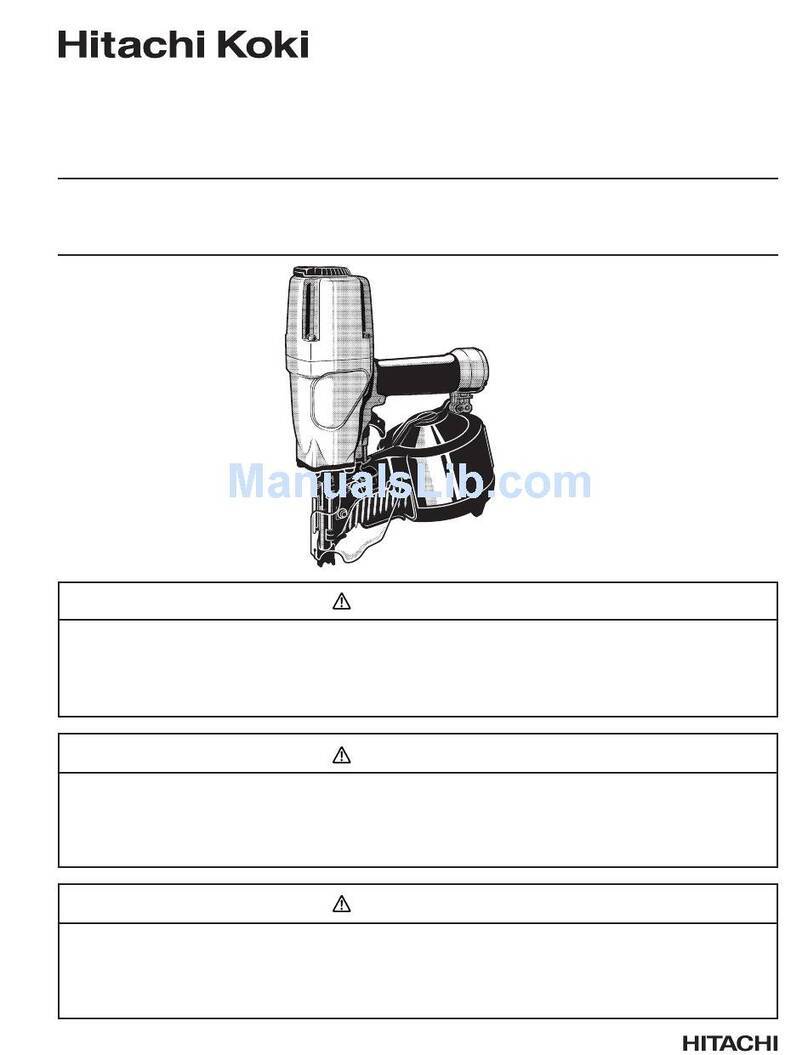
Hitachi Koki
Hitachi Koki NV75AG - 3" Utility Coil Nailer Instruction and safety manual
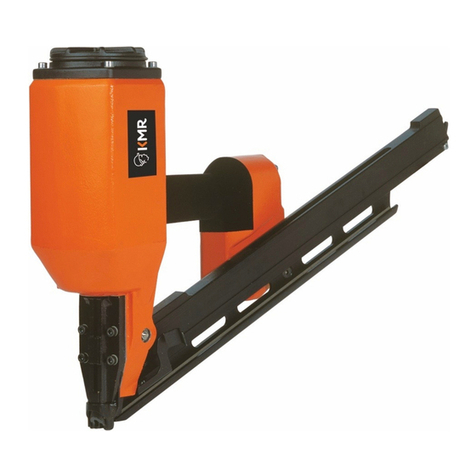
KMR
KMR 3522 Technical data spare parts
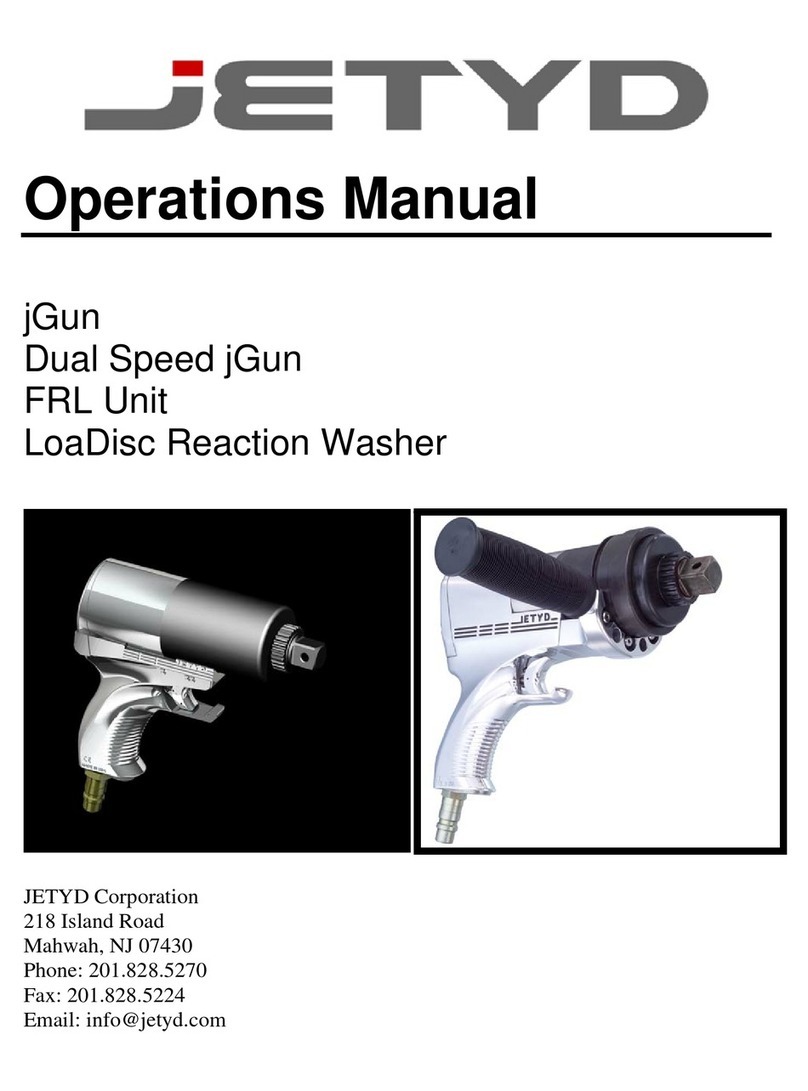
JETYD
JETYD j-Gun series Operation manual
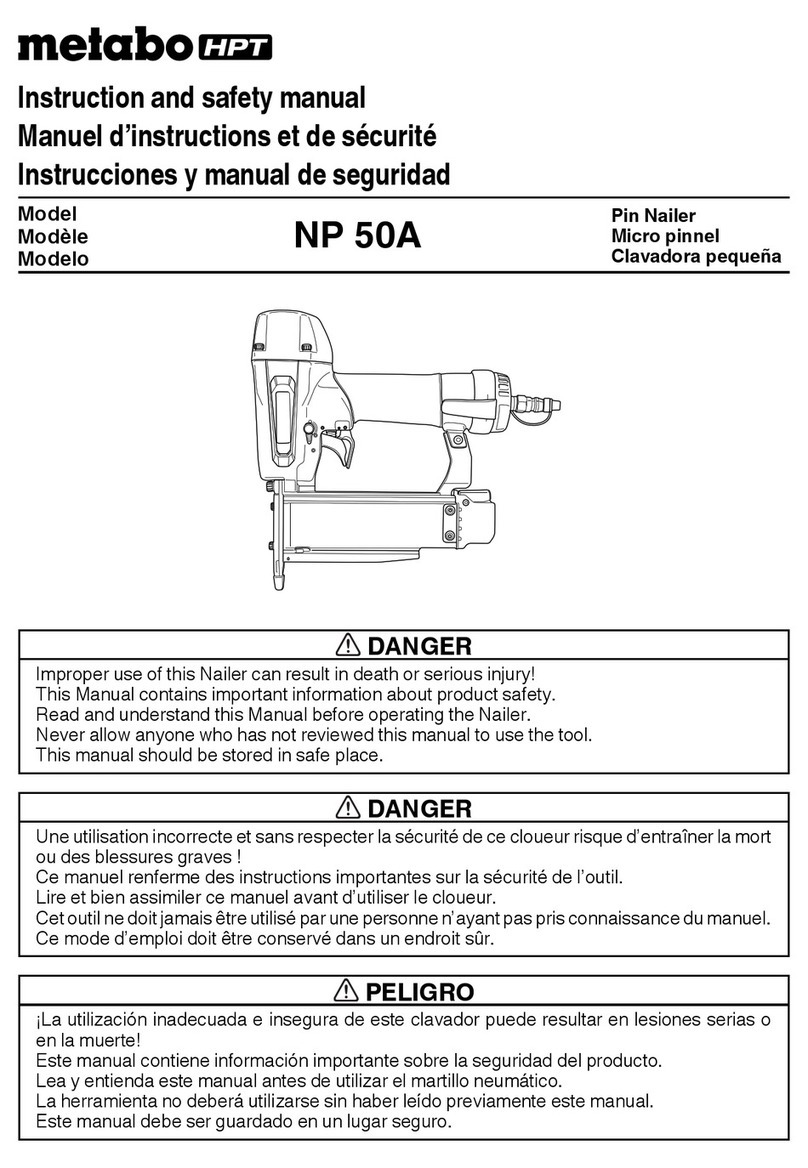
Metabo HPT
Metabo HPT NP 50A Instruction and safety manual
